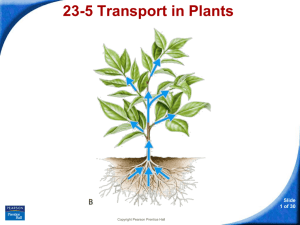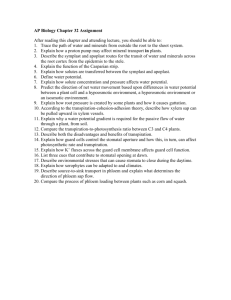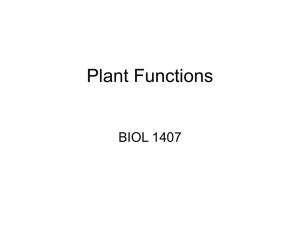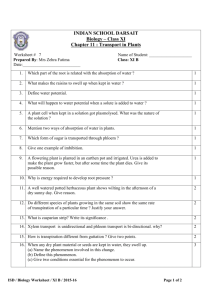23-5 Transport in Plants Slide 1 of 30 End Show
advertisement
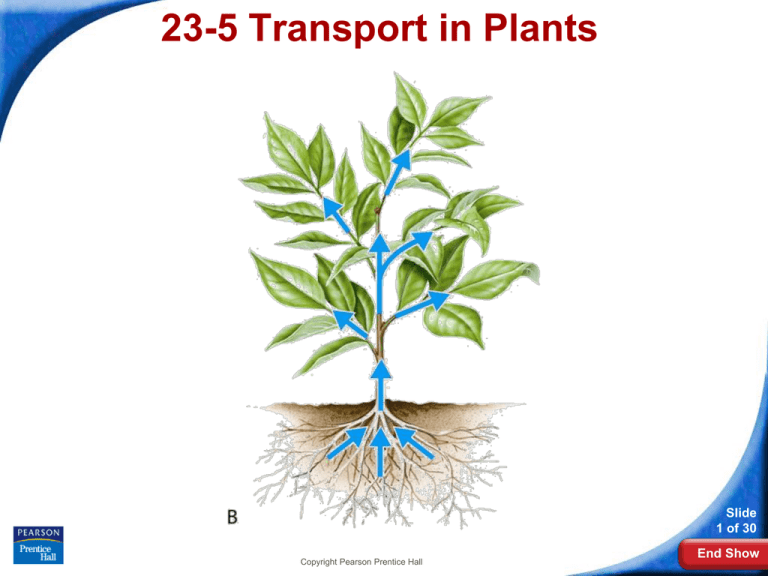
23-5 Transport in Plants Slide 1 of 30 Copyright Pearson Prentice Hall End Show 23-5 Transport in Plants Water Pressure Water Transport Xylem tissue forms a continuous set of tubes that runs from the roots through stems and out into the spongy mesophyll of leaves. Active transport and root pressure cause water to move from soil into plant roots. Capillary action and transpiration also are needed to transport water and minerals. The combination of root pressure, capillary action, and transpiration provides enough force to move water through the xylem tissue of even the tallest plant. Slide 2 of 30 Copyright Pearson Prentice Hall End Show 23-5 Transport in Plants Water Pressure Capillary Action Water molecules are attracted to each other by a force called cohesion. Cohesion is the attraction of molecules of the same substance to each other. Water molecules have a tendency to form hydrogen bonds with each other, and with other substances. Adhesion is the attraction between unlike molecules. Slide 3 of 30 Copyright Pearson Prentice Hall End Show 23-5 Transport in Plants Water Pressure The tendency of water to rise in a thin tube is called capillary action. Water is attracted to the walls of the tube, and water molecules are attracted to one another. Capillary action causes water to move much higher in a narrow tube than in a wide tube. Tracheids and vessel elements form hollow connected tubes in a plant. Capillary action in these structures causes water to rise well above the level of the ground. Copyright Pearson Prentice Hall Slide 4 of 30 End Show 23-5 Transport in Plants Water Pressure Transpiration In tall plants, the major force in water transport comes from the evaporation of water from leaves during transpiration. Slide 5 of 30 Copyright Pearson Prentice Hall End Show 23-5 Transport in Plants Water Pressure When water is lost through transpiration, osmotic pressure moves water out of the vascular tissue of the leaf. Slide 6 of 30 Copyright Pearson Prentice Hall End Show 23-5 Transport in Plants Water Pressure The movement of water out of the leaf “pulls” water upward through the vascular system all the way from the roots. This process is known as transpirational pull. Slide 7 of 30 Copyright Pearson Prentice Hall End Show 23-5 Transport in Plants Water Pressure Controlling Transpiration The water content of the leaf is kept relatively constant. When there is a lot of water, water pressure in the guard cells is increased and the stomata open. Excess water is then lost through the open stomata by transpiration. Slide 8 of 30 Copyright Pearson Prentice Hall End Show 23-5 Transport in Plants Water Pressure When water is scarce, the opposite occurs. Water pressure in the leaf decreases. The guard cells respond by closing the stomata. This reduces further water loss by limiting transpiration. When too much water is lost, wilting occurs. When a leaf wilts, its stomata close and transpiration slows down. This helps a plant conserve water. Slide 9 of 30 Copyright Pearson Prentice Hall End Show 23-5 Transport in Plants Nutrient Transport Nutrient Transport Many plants pump sugars into their fruits. In cold climates, plants pump food into their roots for winter storage. This stored food must be moved back into the trunk and branches of the plant before growth begins again in the spring. Phloem carries out seasonal movement of sugars within a plant. Slide 10 of 30 Copyright Pearson Prentice Hall End Show 23-5 Transport in Plants Nutrient Transport Movement from Source to Sink A process of phloem transport moves sugars through a plant from a source to a sink. A source is any cell in which sugars are produced by photosynthesis. A sink is any cell where the sugars are used or stored. Slide 11 of 30 Copyright Pearson Prentice Hall End Show 23-5 Transport in Plants Nutrient Transport Phloem Xylem One idea that explains how phloem transport takes place is called the pressure-flow hypothesis. Sugars produced during photosynthesis are pumped into the phloem (source). Sugar molecules Source cell Movement of water Movement of sugar Slide 12 of 30 Copyright Pearson Prentice Hall End Show 23-5 Transport in Plants Nutrient Transport Phloem Xylem As sugar concentrations increase in the phloem, water from the xylem moves in by osmosis. Sugar molecules Source cell Movement of water Movement of sugar Slide 13 of 30 Copyright Pearson Prentice Hall End Show 23-5 Transport in Plants Nutrient Transport Phloem Xylem This movement causes an increase in pressure at that point, forcing nutrient-rich fluid to move through the phloem from nutrient-producing regions …. Sugar molecules Source cell Movement of water Movement of sugar Slide 14 of 30 Copyright Pearson Prentice Hall End Show 23-5 Transport in Plants Nutrient Transport …. toward a region that uses these nutrients (sink). Movement of water Movement of sugar Sink cell Copyright Pearson Prentice Hall Phloem Xylem Slide 15 of 30 End Show 23-5 Transport in Plants Nutrient Transport If part of a plant actively absorbs nutrients from the phloem, osmosis causes water to follow. Movement of water Movement of sugar This decreases pressure and causes a movement of fluid in the phloem toward the sink. Sink cell Copyright Pearson Prentice Hall Phloem Xylem Slide 16 of 30 End Show 23-5 Transport in Plants Nutrient Transport When nutrients are pumped into or removed from the phloem system, the change in concentration causes a movement of fluid in that same direction. As a result, phloem is able to move nutrients in either direction to meet the nutritional needs of the plant. Slide 17 of 30 Copyright Pearson Prentice Hall End Show
